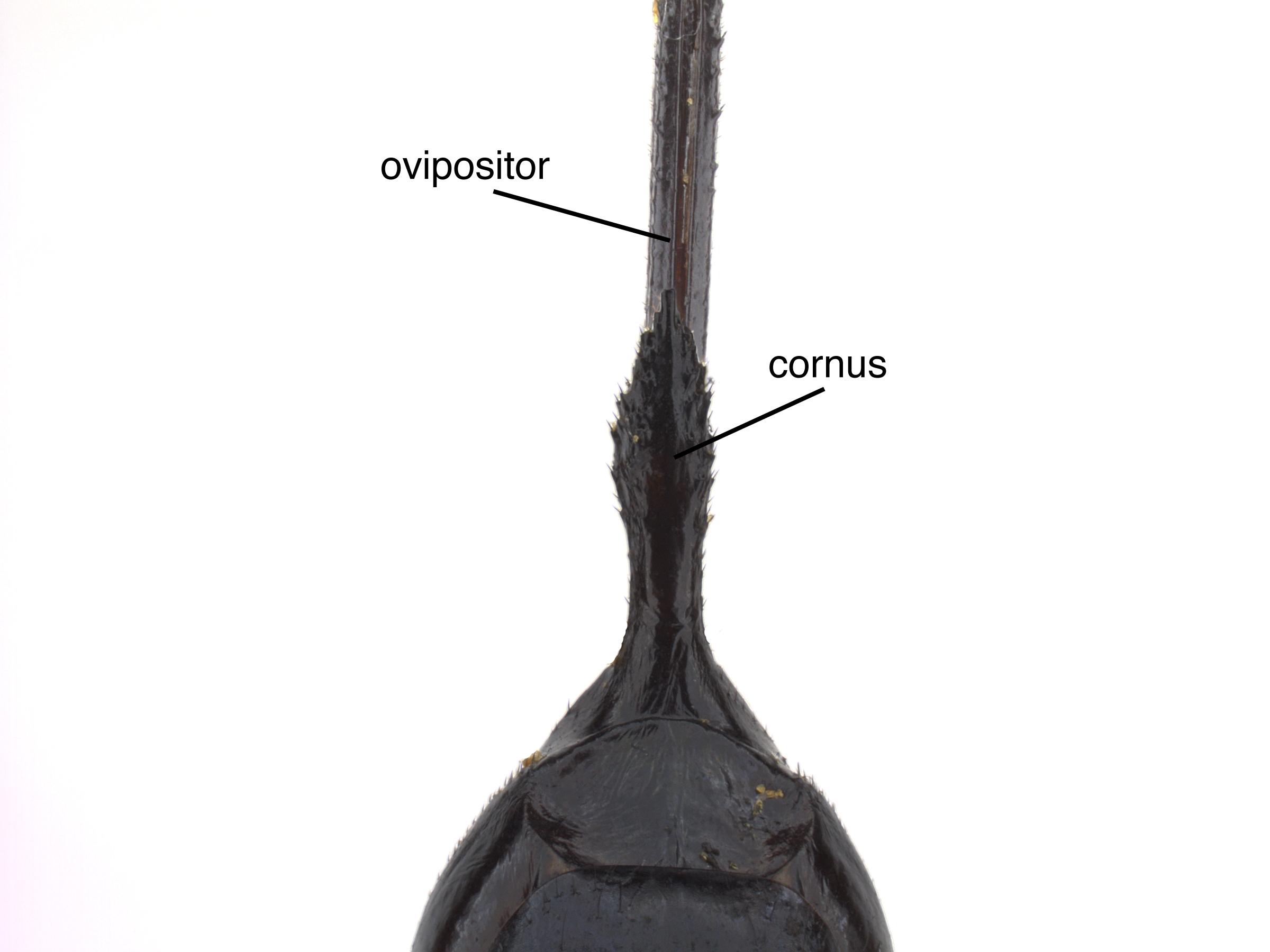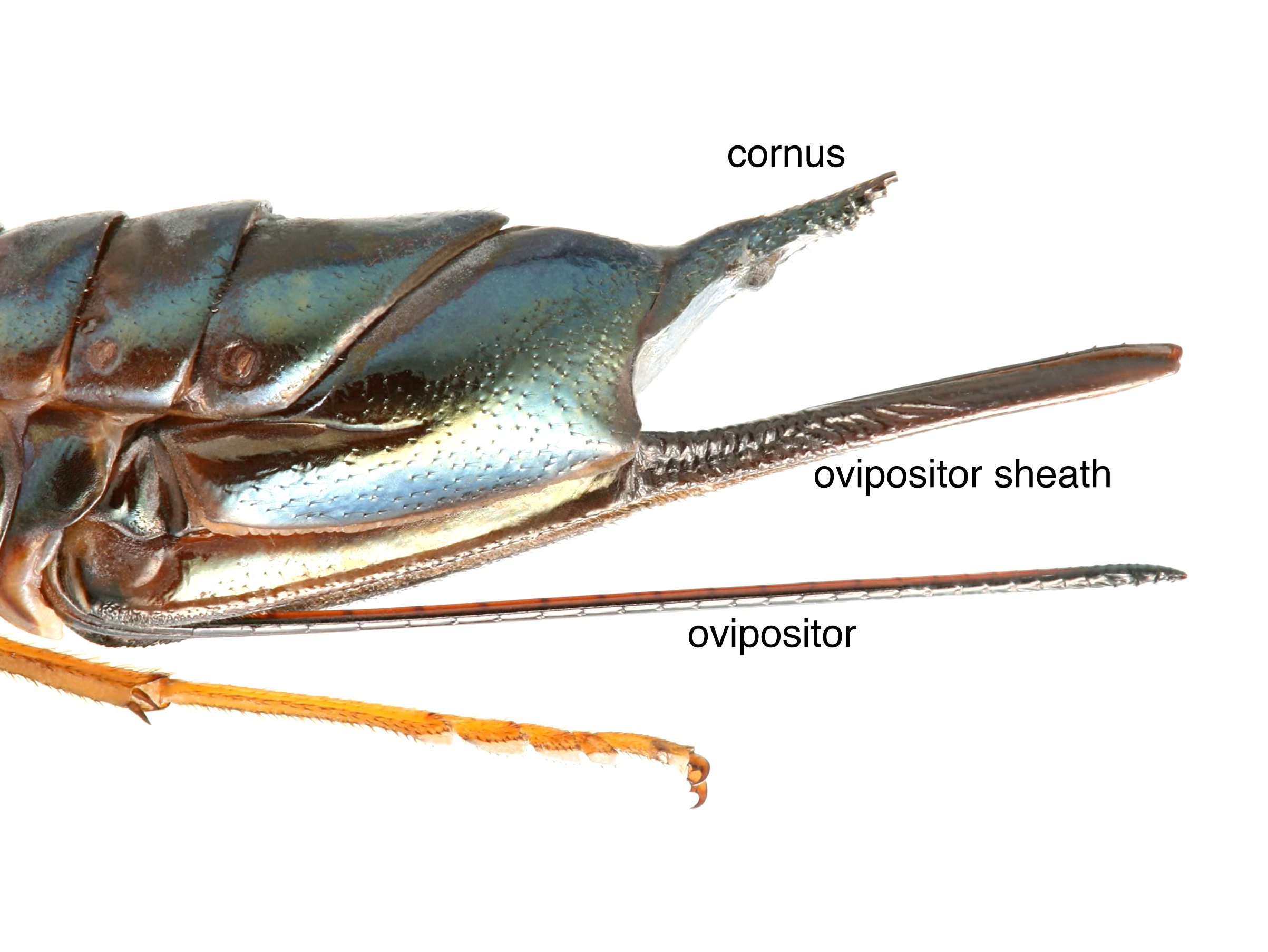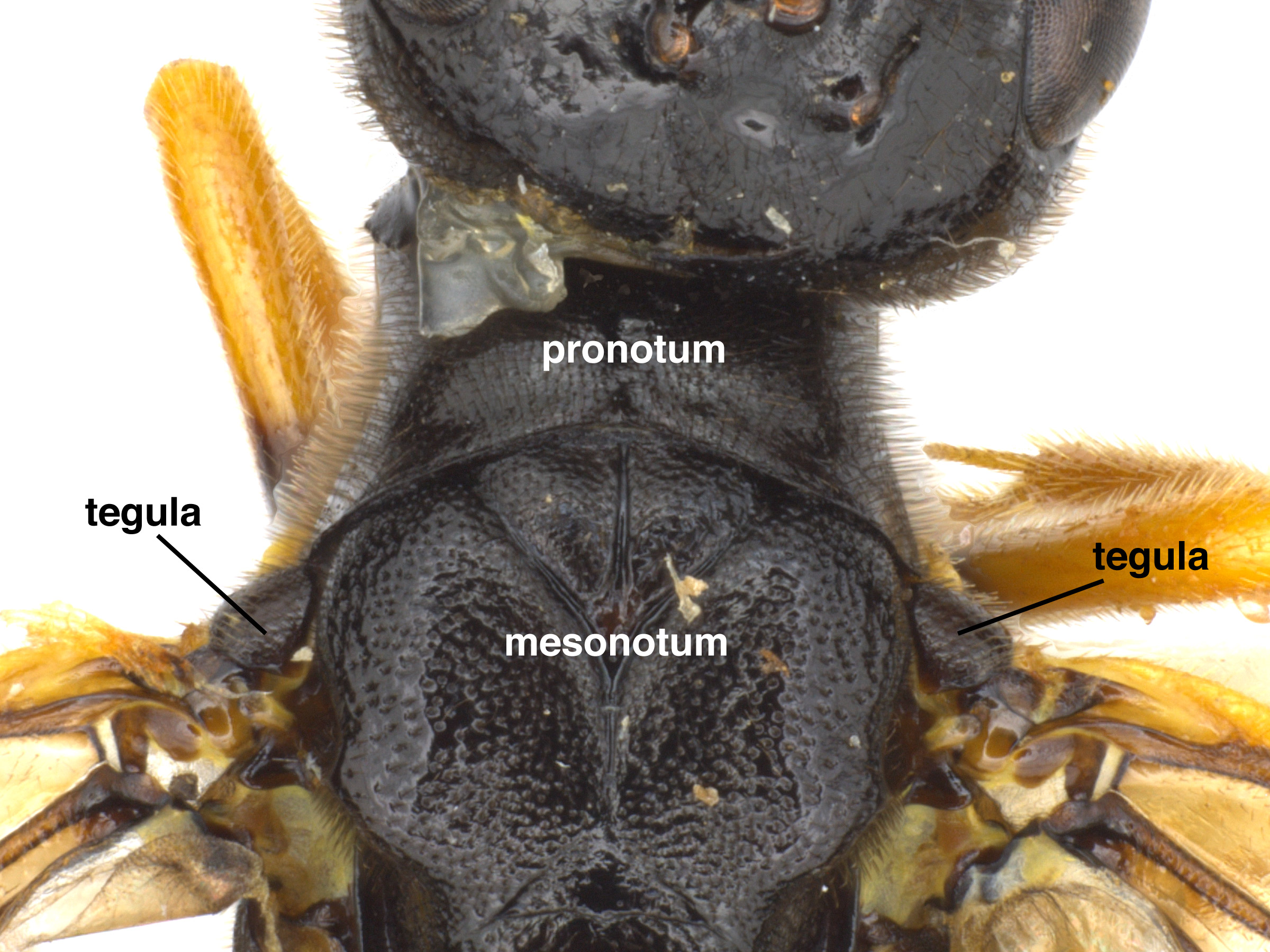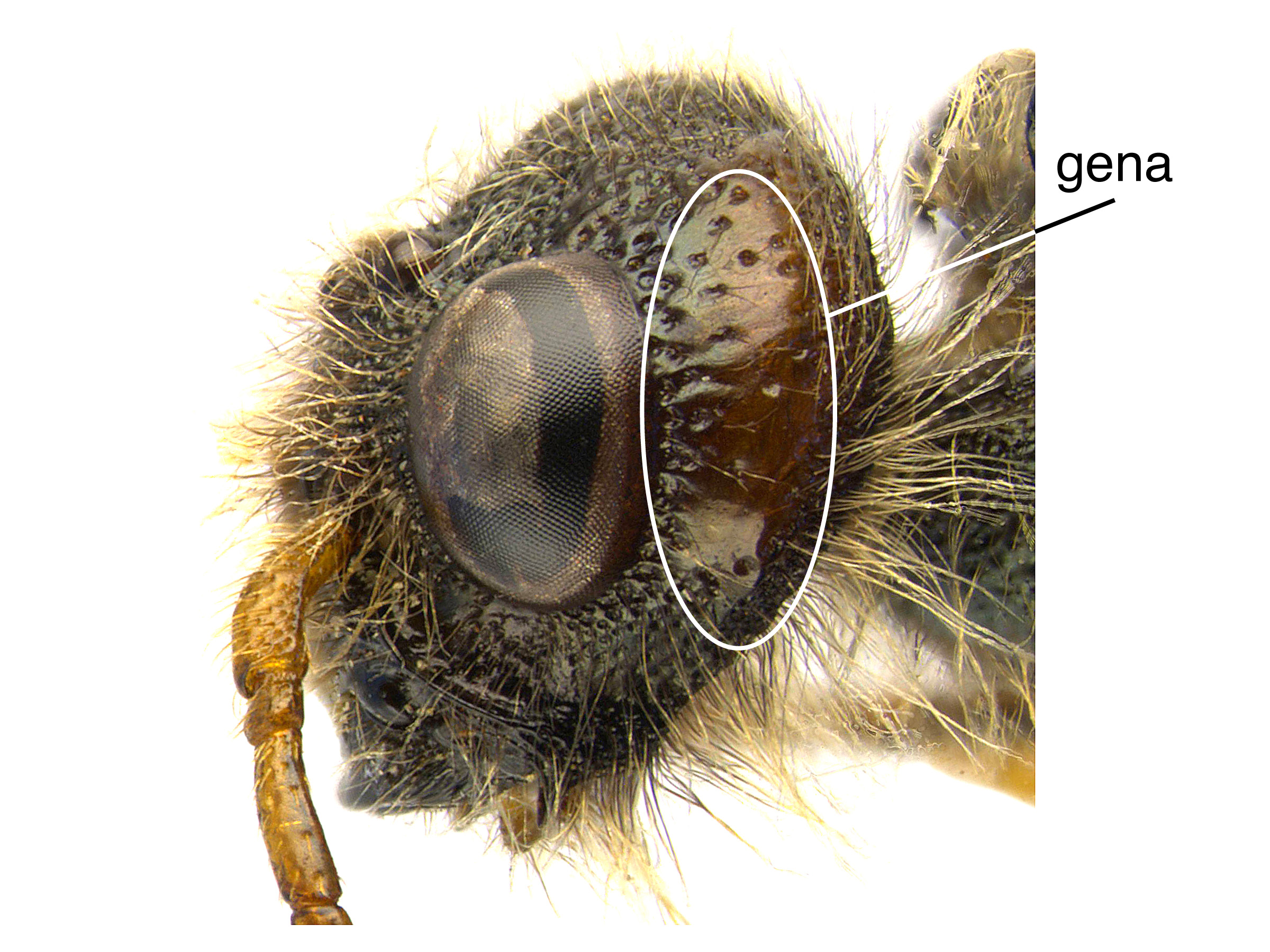Family: Siricidae
Family common name: horntails
Subfamily: Siricinae
Genus: Sirex Linnaeus, 1760
Subgenera: none
The Siricidae are called “horntails” because of the cornuscornus:
a pointed horn-like process on the apical end of the abdomen in Siricidae sawflies; on tergite 10 in females, sternite 9 in males
 , a short spine at the apexapex:
, a short spine at the apexapex:
the end or most distal area of any structure
of the abdomenabdomen:
the third and last segment of an insect's body; in sawflies this is usually made up of 11 segments (segments 9 and 10 often fused) . Females in the family also possess a long, conspicuous ovipositorovipositor:
. Females in the family also possess a long, conspicuous ovipositorovipositor:
the female organ that deposits eggs and is used to drill into plant tissue, located at the apex of the abdomen, made up of the lance and lancet
 . This is often mistaken for a stinger, but it is harmless to animals and used for drilling into wood. This habit has inspired the other common name of this family: “woodwasps” (Klass 1974Klass 1974:
. This is often mistaken for a stinger, but it is harmless to animals and used for drilling into wood. This habit has inspired the other common name of this family: “woodwasps” (Klass 1974Klass 1974:
Klass C. 1974. Horntails or wood wasps. Insect Diagnotic Laboratory Cornell University.).
Horntails of the genus Sirex are generally large, about 2.5–4 cm in length, with cylindrical bodies (Camper and Cranshaw 2018Camper and Cranshaw 2018:
Camper M and Cranshaw W. n.d. European woodwasp/Sirex woodwasp in Colorado - identification of insects and damage of similar appearance. Colorado Exotic Insect Detection and Identification Fact Sheet Series. Online Accessed Dec. 2018., Schiff et al. 2012Schiff et al. 2012:
Schiff NM, Goulet H, Smith DR, Boudreault C, Wilson AD, and Scheffler BE. 2012. Siricidae (Hymenoptera: Symphyta: Siricoidea) of the Western Hemisphere. Canadian Journal of Arthropod Identification 21: 1-305.). They are usually black with metallic reflections, and some have pale reddish and reddish-brown areas (Schiff et al. 2012Schiff et al. 2012:
Schiff NM, Goulet H, Smith DR, Boudreault C, Wilson AD, and Scheffler BE. 2012. Siricidae (Hymenoptera: Symphyta: Siricoidea) of the Western Hemisphere. Canadian Journal of Arthropod Identification 21: 1-305.). Females are generally larger than males, but because body size is highly variable within species, sexes are best distinguished by presence or absence of the long ovipositorovipositor:
the female organ that deposits eggs and is used to drill into plant tissue, located at the apex of the abdomen, made up of the lance and lancet
 (Camper and Cranshaw 2018Camper and Cranshaw 2018:
(Camper and Cranshaw 2018Camper and Cranshaw 2018:
Camper M and Cranshaw W. n.d. European woodwasp/Sirex woodwasp in Colorado - identification of insects and damage of similar appearance. Colorado Exotic Insect Detection and Identification Fact Sheet Series. Online Accessed Dec. 2018.).
Worldwide, there are 28 described species. The highest diversity is in North America, with 13 endemicendemic:
both native and unique to a particular region
and one introduced species (Schiff et al. 2012Schiff et al. 2012:
Schiff NM, Goulet H, Smith DR, Boudreault C, Wilson AD, and Scheffler BE. 2012. Siricidae (Hymenoptera: Symphyta: Siricoidea) of the Western Hemisphere. Canadian Journal of Arthropod Identification 21: 1-305.).
The revision by Schiff et al. 2012Schiff et al. 2012:
Schiff NM, Goulet H, Smith DR, Boudreault C, Wilson AD, and Scheffler BE. 2012. Siricidae (Hymenoptera: Symphyta: Siricoidea) of the Western Hemisphere. Canadian Journal of Arthropod Identification 21: 1-305. covers all Sirex species of the Western Hemisphere. Characters used in this revision were taken from previous work in Ross 1937Ross 1937:
Ross HH. 1937. A generic classification of the Nearctic sawflies (Hymenoptera, Symphyta). University of Ilinois Bulletin 34 (94): 1-173. and Benson 1943Benson 1943:
Benson RB. 1943. Studies in Siricidae, especially of Europe and southern Asia (Hymenoptera, Smphyta). Bulletin of Entomological Research 34 (1): 27-51. https://doi.org/10.1017/S0007485300023464. Throughout the Sirex species pages, and in the key to Sirex species, we primarily cite Schiff et al. 2012Schiff et al. 2012:
Schiff NM, Goulet H, Smith DR, Boudreault C, Wilson AD, and Scheffler BE. 2012. Siricidae (Hymenoptera: Symphyta: Siricoidea) of the Western Hemisphere. Canadian Journal of Arthropod Identification 21: 1-305. because of its use of more modern terminology and current taxonomy.
A key to North American species of Sirex is included in Schiff et al. 2012Schiff et al. 2012:
Schiff NM, Goulet H, Smith DR, Boudreault C, Wilson AD, and Scheffler BE. 2012. Siricidae (Hymenoptera: Symphyta: Siricoidea) of the Western Hemisphere. Canadian Journal of Arthropod Identification 21: 1-305..
 (Schiff et al. 2012Schiff et al. 2012:
(Schiff et al. 2012Schiff et al. 2012: 10 of the female, sternumsternum:
10 of the female, sternumsternum: 9 of the male, known as the cornuscornus:
9 of the male, known as the cornuscornus: (Schiff et al. 2012Schiff et al. 2012:
(Schiff et al. 2012Schiff et al. 2012: cellcell:
cellcell: Cu1 present (Schiff et al. 2012Schiff et al. 2012:
Cu1 present (Schiff et al. 2012Schiff et al. 2012:Sirex can be confused with other Siricidae, especially Urocerus, because of the similar coloration. They can be distinguished from other genera in the family by the lack of ridge on the genagena:
the area of the head between the compound eye and clypeus; also called the cheek
 behind the eye, a lack of light-colored spot on the dorsaldorsal:
behind the eye, a lack of light-colored spot on the dorsaldorsal:
of or on the top surface of the body or structure
portion of the genagena:
the area of the head between the compound eye and clypeus; also called the cheek
 , and lack of constriction at the basebase:
, and lack of constriction at the basebase:
the beginning or most proximal area of any structure
of the cornuscornus:
a pointed horn-like process on the apical end of the abdomen in Siricidae sawflies; on tergite 10 in females, sternite 9 in males
 (Schiff et al. 2012Schiff et al. 2012:
(Schiff et al. 2012Schiff et al. 2012:
Schiff NM, Goulet H, Smith DR, Boudreault C, Wilson AD, and Scheffler BE. 2012. Siricidae (Hymenoptera: Symphyta: Siricoidea) of the Western Hemisphere. Canadian Journal of Arthropod Identification 21: 1-305.).
Siricidae are commonly intercepted in wood packing materials at ports of entry. The potential of larval stages to persist and develop for multiple years increases the potential of successful establishment from improperly treated or disposed of wood material. One species is established and invasive in North America, South America, South Africa, New Zealand, and Australia (Schiff et al. 2012Schiff et al. 2012:
Schiff NM, Goulet H, Smith DR, Boudreault C, Wilson AD, and Scheffler BE. 2012. Siricidae (Hymenoptera: Symphyta: Siricoidea) of the Western Hemisphere. Canadian Journal of Arthropod Identification 21: 1-305.). Read more details on the species factsheet: Sirex noctilio.
In North America, Sirex species have been documented using host trees in the Cupressaceae and Pinaceae, including Cupressus spp. (cypress), Taxodium distichum (bald cypress), Juniperus spp. (juniper), Calocedrus decurrens (incense-cedar), Thuja plicata (redcedar), Sequoia sempervirens (coast redwood), Abies spp. (fir), Larix spp. (larch), Picea spp. (spruce), Pinus spp. (pine), Pseudotsuga menziesii (Douglas fir) and Tsuga heterophylla (western hemlock) (Schiff et al. 2012Schiff et al. 2012:
Schiff NM, Goulet H, Smith DR, Boudreault C, Wilson AD, and Scheffler BE. 2012. Siricidae (Hymenoptera: Symphyta: Siricoidea) of the Western Hemisphere. Canadian Journal of Arthropod Identification 21: 1-305.).
Female Sirex harbor symbiotic basidiomycete fungus in abdominal glands called mycangia. During oviposition, the site is inoculated with the fungus, which begins to decompose the surrounding wood. LarvaeLarva:
the immature stage of holometabolous insects
 feed on the fungus and in the process bore galleries through the wood. The fungal symbiont for three species of Sirex (S. noctilio, S. nitobei, and S. juvencus) has been identified as Amylostereum areolatum, and for six others (S. cyaneus, S. imperialis, S. aereolatus, S. californicus, S. nigricornis, and S. varipes) as Amylostereum chailletti. Females reserve mucus in additional abdominal glands, but the function of these reservoirs in species other than Sirex noctilio is not well understood. Sirex noctilio uses the mucus as a phytotoxinphytotoxic:
feed on the fungus and in the process bore galleries through the wood. The fungal symbiont for three species of Sirex (S. noctilio, S. nitobei, and S. juvencus) has been identified as Amylostereum areolatum, and for six others (S. cyaneus, S. imperialis, S. aereolatus, S. californicus, S. nigricornis, and S. varipes) as Amylostereum chailletti. Females reserve mucus in additional abdominal glands, but the function of these reservoirs in species other than Sirex noctilio is not well understood. Sirex noctilio uses the mucus as a phytotoxinphytotoxic:
toxic to plants; poisons and sometimes kills plant tissue
to weaken the tree, while the mucus in other species may just encourage fungal growth. Sirex species drill holes in trees for oviposition, but often drill holes without depositing an egg and/or fungus (Schiff et al. 2012Schiff et al. 2012:
Schiff NM, Goulet H, Smith DR, Boudreault C, Wilson AD, and Scheffler BE. 2012. Siricidae (Hymenoptera: Symphyta: Siricoidea) of the Western Hemisphere. Canadian Journal of Arthropod Identification 21: 1-305.). Eggs are laid singly (Klass 1974Klass 1974:
Klass C. 1974. Horntails or wood wasps. Insect Diagnotic Laboratory Cornell University.).
Larvae are creamy white and grub-like in appearance with a dark head capsule. As with adults, larvaelarva:
the immature stage of holometabolous insects
 possess a short dorsaldorsal:
possess a short dorsaldorsal:
of or on the top surface of the body or structure
horn on the posterior end of the body. At maturity, the body measures about 2.5 cm in length (Camper and Cranshaw 2018Camper and Cranshaw 2018:
Camper M and Cranshaw W. n.d. European woodwasp/Sirex woodwasp in Colorado - identification of insects and damage of similar appearance. Colorado Exotic Insect Detection and Identification Fact Sheet Series. Online Accessed Dec. 2018.). The larvaelarva:
the immature stage of holometabolous insects
 bore galleries 5–20 cm long while developing through 6–12 larval instars, depending on food availability, until pupation and subsequent emergence. Throughout this process, the larvaelarva:
bore galleries 5–20 cm long while developing through 6–12 larval instars, depending on food availability, until pupation and subsequent emergence. Throughout this process, the larvaelarva:
the immature stage of holometabolous insects
 use their horn to pack the tunnel behind them with sawdust. Emergence holes are perfectly circular. The fungal symbiont is carried in specialized organs in female larvaelarva:
use their horn to pack the tunnel behind them with sawdust. Emergence holes are perfectly circular. The fungal symbiont is carried in specialized organs in female larvaelarva:
the immature stage of holometabolous insects
 that develop into the mycangia after metamorphosis. The life cycle of Sirex species varies from 1–3 years (Schiff et al. 2012Schiff et al. 2012:
that develop into the mycangia after metamorphosis. The life cycle of Sirex species varies from 1–3 years (Schiff et al. 2012Schiff et al. 2012:
Schiff NM, Goulet H, Smith DR, Boudreault C, Wilson AD, and Scheffler BE. 2012. Siricidae (Hymenoptera: Symphyta: Siricoidea) of the Western Hemisphere. Canadian Journal of Arthropod Identification 21: 1-305.).
Adult males have been observed swarming and waiting for a female to enter the swarm for mating. There is some evidence that trees with sustained damage, either from drought-related stress, weather, or other insect infestations, are preferred as hosts (Burnip et al. 2010Burnip et al. 2010:
Burnip GM, Voice D, and Brockerhoff EG. 2010. Interceptions and incursions of exotic Sirex species and other siricids (Hymenoptera: Siricidae). New Zealand Journal of Forestry Science 40: 133-140.). In some cases, females oviposit in fire-damaged trees. Adult Siricidae are not well-studied (Schiff et al. 2012Schiff et al. 2012:
Schiff NM, Goulet H, Smith DR, Boudreault C, Wilson AD, and Scheffler BE. 2012. Siricidae (Hymenoptera: Symphyta: Siricoidea) of the Western Hemisphere. Canadian Journal of Arthropod Identification 21: 1-305.).
World: Except for one species, Sirex is restricted to the Northern Hemisphere. Species are found throughout Europe, Western Asia, India, China, Korea and Japan. Sirex noctilio is documented in all the regions above plus Mongolia, as well as being introduced and established in South Africa, New Zealand, Australia, and North and South America (Smith 1978Smith 1978:
Smith DR. 1978. Suborder Symphyta (Xyelidae, Parachexyelidae, Parapamphiliidae, Xyelydidae, Karatavitidae, Gigasiricidae, Sepulcidae, Pseudosiricidae, Anaxyelidae, Siricidae, Xiphydriidae, Paroryssidae, Xyelotomidae, Blasticotomidae, Pergidae). Hymenopterorum Catalogus 14: 1-193.).
North America: Sirex occurs throughout Canada and the United States. Several species are restricted to Mexico, Honduras, Guatemala and the Caribbean islands. Generally Sirex are established where coniferousconiferous:
describing a conifer
trees grow densely, most often along mountain ranges in the boreal north, far west, far east, and southwest desert of continental North America, with one species occurring above 1000 meters in the Greater Antilles of the Caribbean (Smith 1978Smith 1978:
Smith DR. 1978. Suborder Symphyta (Xyelidae, Parachexyelidae, Parapamphiliidae, Xyelydidae, Karatavitidae, Gigasiricidae, Sepulcidae, Pseudosiricidae, Anaxyelidae, Siricidae, Xiphydriidae, Paroryssidae, Xyelotomidae, Blasticotomidae, Pergidae). Hymenopterorum Catalogus 14: 1-193.).
Map data from: GBIF.org (26 June 2019) GBIF Occurrence Download Sirex
Details about data used for maps can be found here.